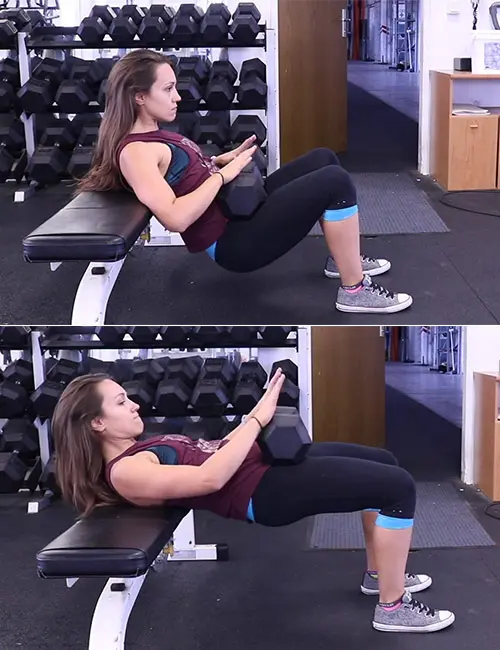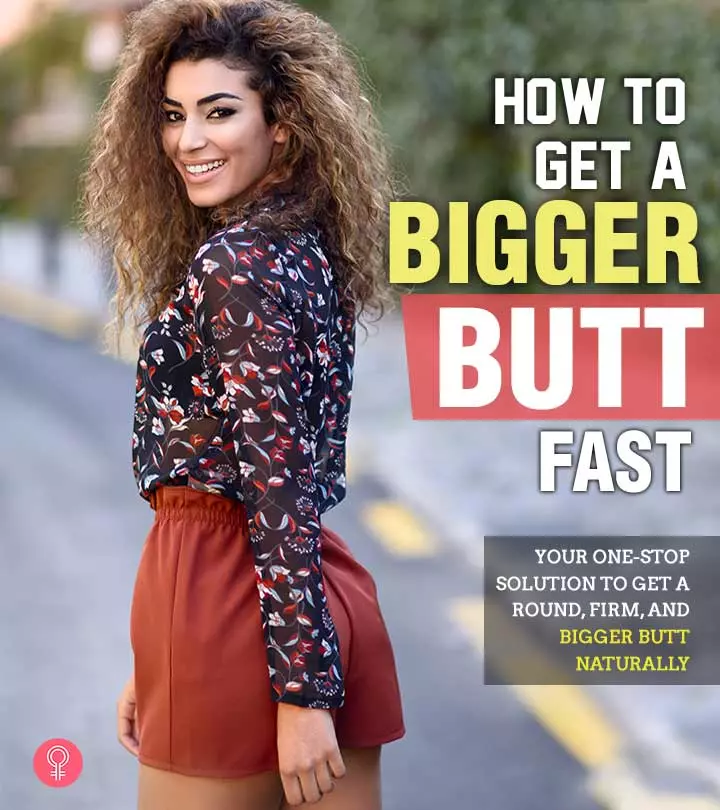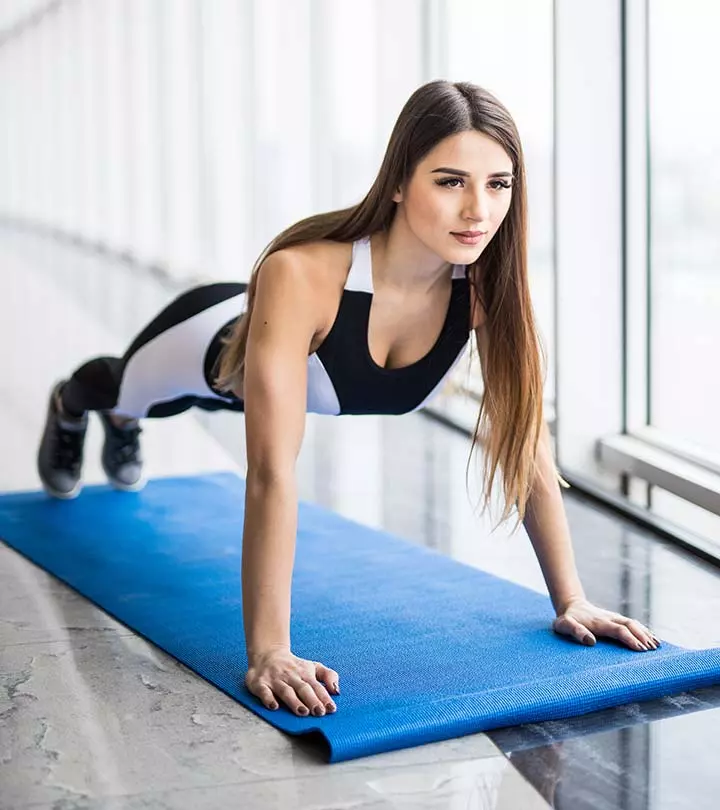Hip Thrust Exercise: 5 Variations For Stronger, Toned Glutes
Improve your posture, agility, and coordination while staying fit and healthy!

Image: Shutterstock
There’s more to strong, round, and toned glutes than just being aesthetically pleasing. They also determine your balance and stability. Hip thrust exercises help you achieve that (1). In addition, there are many other benefits of hip thrust exercises. Performing these regularly can help reduce back pain and reduce hip flexor inflammation and tightness. Hip thrust exercises also help correct posture, improve hip-to-knee coordination, and power one’s athletic performance (2). Here’s how to do hip thrust exercises with 5 variations to get that strong, toned butt.
 Workout Blueprint: Hip Thrusts
Workout Blueprint: Hip Thrusts- Frequency: 2-3 times per week
- Benefits: Improve lower body strength, stability, and posture.
- Equipment Needed: Bench, resistance band, dumbbells, barbell, mat.
- Space Required: Large area
- Assistance Required: Yes
- Who Should Avoid: Anyone with lower back pain, spine problems, or other bone conditions.
In This Article
What Is Hip Thrust?

The hip thrust was invented and popularized by Bret Contreras. It is an advanced and more effective version of the bridge exercise. Although both help in strengthening the hips, lower back, and thighs, the hip thrust is more challenging as you will do it at an elevation using your body weight or dumbbells, barbells, chains, and bands. Here’s how to do hip thrusts properly.
Key Takeaways
- Hip thrusts focus on glute activation, leading to improved balance and stability.
- Hip thrusts also help boost lower body strength and build muscle mass.
- Add them to your regular workout routine which can lead to improved hip abduction & increased hip mobility and minimize the risk of injury.
- Try hip thrusts with barbells, dumbbells, or resistance bands for better overall fitness and to make the most of your workout.

Hip Thurst Exercise – How To Do It Correctly
Here are the steps to do hip thrust or bodyweight hip thrust exercise correctly.
The Starting Position
- Sit with your shoulder against an exercise bench or a sofa, with your knees bent and feet flat.
- Keep your arms on the bench or the sofa, with your fingers pointing toward your lower body.
The Movement
- Push your hips toward the ceiling, forming a straight line from the shoulders to the knees, without raising your feet or shoulders off the floor.
- Squeeze your butt cheeks together when you thrust your hips up.
- Slowly lower your hips.
Repeat
- Before your hips touch the floor, thrust your hips up again.
- Do 3 sets of 8 reps if you are a beginner.
If you are wondering how to get a bigger butt fast or contemplating exercises for toned, attractive quads, then the following variations of the hip thrust exercise are ideal.
5 Best Hip Thurst Exercises To Make Your Butt Look Good
1. Hip Thrust With Resistance Band

Doing hip thrusts with a resistance band increases resistance to target the glutes, hamstrings, and core even more. This variation increases muscular engagement without needing large weights and helps strengthen and stabilize the lower body.
Steps To Do The Hip Thrust With Resistance Band
- Place two 100-pound dumbbells on either side of a secure bench.
- Attach each end of a resistance band to each dumbbell.
- Slide underneath the band. Flex your knees, keep your feet flat on the floor, and legs hip-width apart.
- Keeping your upper back against the bench, extend your arms laterally, and keep them up on the bench.
- Take a deep breath and exhale through your mouth. Engage your core and lift your hips. Do not tuck your chin. Keep your neck in a neutral position and look up at the ceiling.
- Hold this pose for a moment and then lower your hips.
- Do not let your hips touch the floor before completing one set. Do 3 sets of 12 reps. Rest 10 seconds between the sets.
2. Dumbbell Hip Thrust

The dumbbell hip thrust is a lower-body exercise that works the hamstrings, quadriceps, core, and glutes. It enhances the workout by adding resistance with a dumbbell on the hips, increasing stability, strength, and muscular definition.
Steps To Do The Dumbbell Hip Thrust
- Place the dumbbells on either side.
- Lie down on a mat. Keep your knees flexed, feet flat on the ground and hip-width apart, and ankles right below your knees.
- Grab a dumbbell in each hand and place them right on your pelvic region.
- Push up with your heels. Exhale and raise your hips toward the ceiling. Feel the resistance in your glutes.
- Hold this pose for a second. Inhale and lower your hips. Do not let your hips touch the mat before completing the set. Do 3 sets of 10 reps. Rest 10 seconds.
 Quick Tip
Quick Tip3. Barbell Hip Thrust

A common lower-body exercise, well-known for strengthening the glutes, increasing hip stability, and improving overall athletic performance, is the barbell hip thrust. This workout is a favorite for people who want to increase their lower body strength and glute development because it works the glutes hard and uses a barbell for added resistance.
Steps To Do The Barbell Hip Thrust
- Sit in front of a bench and place a barbell on your pelvic region.
- Keep the upper back against the bench, place your upper arms on the bench, flex your elbows, bring your forearms towards your body, and grab the bar of the barbell.
- Flex your knees. Keep your feet flat on the floor and hip-width apart.
- Take a deep breath and exhale through your mouth. Engage your core and lift your buttocks toward the ceiling. Look up at the ceiling and keep your neck in a neutral position.
- Hold this pose for a second and then lower your hips back to the starting position. Do 3 sets of 10 reps and take 10 seconds rest between the sets.
4. Single Leg Hip Thrust

This exercise targets the glutes and strengthens and balances the muscles on each side of the lower body. It also improves lower-body control and stability by raising one leg off the ground, challenging the core and stabilizing muscles.
Steps To Do The Single Leg Hip Thrust
- Sit on the floor with your shoulders against an exercise bench or a sofa. Extend one leg and keep the other leg flexed.
- Push your hips up, keeping one leg extended.
- Slowly lower your hips down.
- Push your hips up again before they touch the floor.
- Do 2 sets of 8 reps and take 10 seconds rest between the sets.
- Extend the other leg and do the same.
Lindsay, a fitness blogger, tried hip thrust exercises to tone her glutes. In her blog, she writes, “I tried, and I got stronger on them, but I just stopped enjoying them. So while I think that hip thrusts are a great exercise for some people, I feel that for the purposes of training my glutes, there are better exercises for me. Single leg hip thrusts are a great alternative to barbell hip thrusts (i).”
5. Single Leg Dumbbell Hip Thrust

The single-leg dumbbell hip thrust is a powerful exercise for developing the glutes and hamstrings as well as balance and stability because it combines the unilateral strength of the single-leg hip thrust with additional resistance from a dumbbell.
- Place a close-ended wide resistance band just above your knee. Hold a dumbbell and sit on the floor with your shoulders against an exercise bench or sofa.
- Place the dumbbell right above your pelvic area. Extend one leg and keep the other flexed.
- Push your hips up, pause, and lower your hips.
- Thrust your hips up again before they touch the floor.
- Do 2 sets of 8 reps and take 10 seconds rest between the sets.
- Extend the other leg and do the same.
These were the 5 hip thrust exercises that you can do. Here are the benefits of hip thrust exercise.
Hip Thrust Exercise Benefits
- Improves glute strength, shape, and size.
- Improves glute muscle power.
- Helps you slay squats and deadlifts.
- Strengthens the lower back and leg muscles.
- Improves body posture.
- Refines leg, ankle, knee, pelvis, and hip movements.
- Activates more muscle fiber in glutes than other exercises.
- Provides good stability to the lower spine.
As you can see, the benefits of doing these lower body exercises for women and men, are multifold. If you are new to this, surely you have a bunch of questions. We have answered a few commonly asked questions in the following sections that will help you understand what muscles you will work on, the exercise time duration, and much more. Scroll down.
What Do You Need To Do Hip Thrust Exercises?
- Comfortable clothes
- Yoga mat
- A secure bench
- Dumbbells
- Barbell
What Is The Time Needed To Do Hip Thrust Exercises?
Take about 15-20 minutes to do at least 2 variations of hip thrust exercises. Make sure you do 3 reps of each variation. Take a few seconds rest between each rep and set.
Which Muscles Does The Hip Thrust Exercise Target?
The hip thrust exercise targets the glutes, as well as a good way for activating the hamstrings, quads, hip flexors, and lower back muscles.
 Quick Tip
Quick TipDo I Need To Warm Up Before Doing The Hip Thrust Exercise?
Yes, absolutely. You must take 10 minutes to warm up. If you don’t, you may injure your glutes, quads, and hamstrings.
It is one thing to make mistakes when you exercise and another not to correct them. An incorrect form will make you prone to injuries and prevent you from reaping all the benefits of the exercise. Keep the following points in mind when you do hip thrust exercises.
Hip Thrust Exercises – Common Mistakes
- Avoid excessive arching of your back. This happens when the weight of the barbell, dumbbell, or chain is way too much for you.
- You might involuntarily tuck your neck. However, make a conscious effort not to do so. Look up at the ceiling when you thrust your hips up.
- When you raise your hips, keep your feet flat on the ground. Do not raise your heels.
- Avoid doing the “half hip thrust”. Raise your hips so that your head, neck, and tailbone are in the same line.
In case you are looking for alternatives to hip thrust exercises, we have you covered. Several effective options can help target the same muscle groups, including the glutes and hamstrings. Check them out in the section below.
Hip Thrust Alternatives
- Lunges: Put one leg forward while you keep the other leg stationary. Bend your knees and lower your body. Engage your core muscles before pushing your front leg to get back to the starting position.
- Step-Ups: Step onto a bench or box as you push your body upward. This engages your glutes and hamstrings.
- Bulgarian Split Squats: Elevate one foot on a bench or platform and perform single-leg squats.
- Single-Leg Deadlift: Stand on one leg and hinge at the hips while lowering a weight, like a dumbbell, toward the floor.
- Squats: Stand with your feet wider than your hips, bend your knees, push your hips back, and lower your body.
Infographic: 8 Hip Thrust Exercise Benefits
The strength of your hips and glutes determines your balance and stability. Hip thrust exercises help correct your posture, improve your hip-knee coordination, giving better running form and enhanced athletic performance. Check out the infographic below to learn how hip thrust exercises can benefit you.
Some thing wrong with infographic shortcode. please verify shortcode syntax
The benefits of hip-thrust exercises begin with helping you improve your balance and stability. These are great glute exercises, which help strengthen the hips, thighs, lower back, and are an advanced and more difficult version of bridge exercises. However, they are highly effective, giving improved posture. It enhances the shape and size of your glutes, and improves your knee, pelvis, hip, leg, and ankle movements. Additionally, it may aid in better body composition. Hip thrusts may also potentially help in reduced risk of ACL injuries indirectly by strengthening the muscles that support the hip, knee, and ankle joints. It may also help in reduced risk of IT band syndrome. Remember that it is important to do these exercises in proper form to reduce risk of injury, and warming up for at least 10 minutes is a must. Talk to your physiotherapist to figure out the best form to do these exercises.
Frequently Asked Questions
Are glute bridges or hip thrusts better?
Both are good for shaping up your buttocks. But bridges tend to overextend the lower back, which may lead to injuries.
What’s the difference between the glute bridge and the hip thrust?
The difference between the glute bridge and the hip thrust is that you do the glute bridge lying down on the floor and perform the hip thrust sitting up with your shoulders against an exercise bench or a sofa.
What are hip dips?
Hip dips is an inward curve that you can observe on the side of your hips. It can appear due to fluctuating body weight or can be genetic.
Are hip thrusts better than squats?
Both exercises work different areas of your body. Hip thrusts are good for toning your glutes while squats are perfect for improving your strength and giving increased muscle mass.
Do hip thrusts make your waist smaller?
Intense lower body exercises like hip thrusts help lose weight and improve the shape of the waistline. This may make your waist appear smaller.
Do hip thrusts work abs?
While hip thrusts focus on working your hip muscles to a large degree, it also focuses on working your glutes and strengthening your abdominal muscles.
How much weight is good for hip thrusts?
Anecdotal evidence suggests that lifting 8-10 kg weights is ideal for hip thrust exercises.
Should I do hip thrusts or squats first?
This depends on your personal preference. If you want to work your glutes, you can start with hip thrusts. If you want to tone your lower body, you can start with squats.
Can I do a hip thrust workout two days in a row?
Yes, you can do hip thrust two days in a row. However, it is recommended that you take adequate rest and practice hip thrusts twice or thrice a week to avoid any injuries.
References
Articles on StyleCraze are backed by verified information from peer-reviewed and academic research papers, reputed organizations, research institutions, and medical associations to ensure accuracy and relevance. Read our editorial policy to learn more.
- Effects of 7-Week Hip Thrust Versus Back Squat Resistance Training on Performance in Adolescent Female Soccer Players, Sports, US National Library of Medicine, National Institutes of Health.
https://www.ncbi.nlm.nih.gov/pmc/articles/PMC6524379/ - Effects of a Six-Week Hip Thrust vs. Front Squat Resistance Training Program on Performance in Adolescent Males: A Randomized Controlled Trial, Journal of Strength and Conditioning Research, US National Library of Medicine, National Institutes of Health.
https://pubmed.ncbi.nlm.nih.gov/27253835/
Read full bio of Dr. Sudhansu Singh
Read full bio of Ravi Teja Tadimalla
Read full bio of Himanshi Mahajan



























Community Experiences
Join the conversation and become a part of our empowering community! Share your stories, experiences, and insights to connect with other beauty, lifestyle, and health enthusiasts.